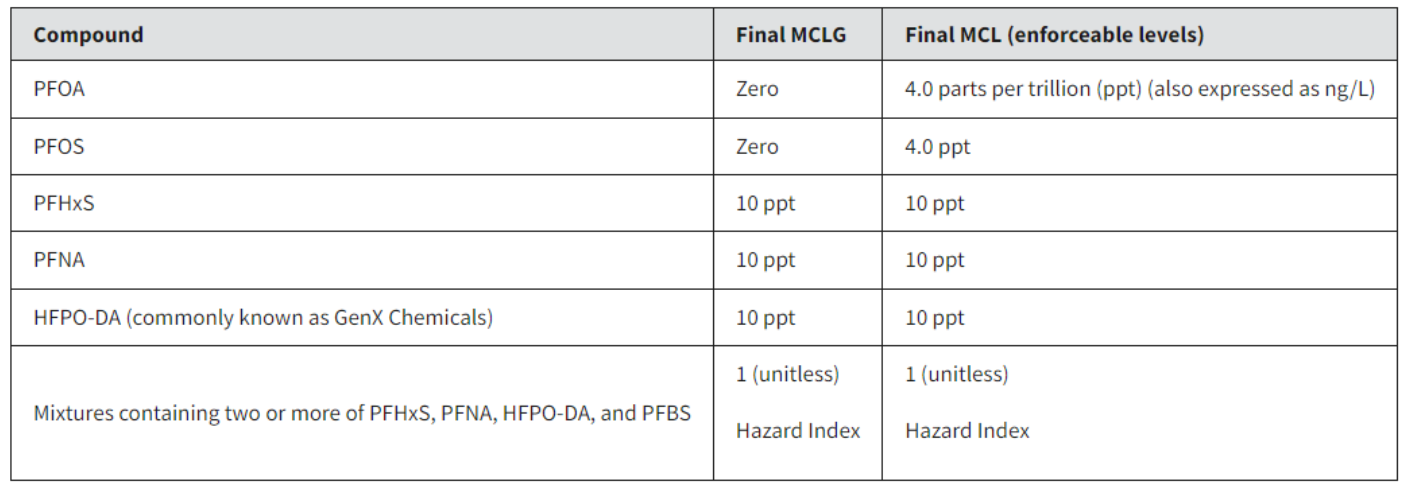
There’s an invisible threat lurking in our tap water known as per- and polyfluoroalkyl substances – or PFAS, for short. Dubbed “forever chemicals” due to their stubborn persistence in the environment and our bodies.
These man-made chemicals are now being scrutinized closely by the Environmental Protection Agency (EPA), which has proposed new regulations to ensure our tap water remains safe and sustainable. So, how many PFAS in tap water should concern us? Let’s dive into this pressing question and the details of the new PFAS tap water regulations to better understand the implications for us as consumers.
Understanding PFAS
Before we delve into the new regulations, it’s important to understand what PFAS are and why they’re concerning. Per- and polyfluoroalkyl substances (PFAS) are a group of over 4,700 synthetic chemicals that have been used in various industries around the globe since the 1940s. PFAS are characterized by their super-strong carbon-fluorine bonds, which is one of the strongest in organic chemistry. This makes them incredibly resistant to degradation, earning them the label “forever chemicals.”
Where Are PFAS Found?
PFAS have been utilized in a multitude of products due to their unique properties such as water and oil repellency, temperature resistance, and friction reduction, including:
- Food Packaging: pizza boxes, food wrappers, take out containers, microwave popcorn bags, disposable trays, and bakery bags;
- Non-stick pans (Teflon)
- Firefighting foam
- Carpets, rugs, furniture textiles, window treatments, car seats
- Stain-proof and waterproof clothing
- Outdoor gear
- Umbrellas
- Personal care products like dental floss, mascara, foundation, menstrual underwear
- Artificial turf
- Medical equipment and masks
- Building products
- Firefighters’ personal protective equipment, and more
Furthermore, PFAS are present in industrial processes such as chrome plating, electronics manufacturing, and aviation.
The Health Implications of PFAS
The longevity of PFAS in the environment has severe health implications. Studies have linked these chemicals to an array of health problems, including certain cancers, liver damage, decreased fertility, increased risk of asthma, and reduced vaccine effectiveness, among others. The pervasive nature of these contaminants means that they’ve been detected in water supplies across the United States, affecting millions of Americans.
PFAS are extremely persistent, lasting thousands of years. According to the CDC, 98% of Americans have some level of PFAS in their blood.

Understanding PFAS Levels in Tap Water
There are currently more than 4,700 different PFAS compounds, and the number is ever-growing. However, not all PFAS are well-researched or understood, and only a few have been studied extensively enough to draw conclusions about their safety.
Two of the most well-known and researched PFAS compounds, PFOA (perfluorooctanoic acid) and PFOS (perfluorooctanesulfonic acid), have been voluntarily phased out by manufacturers in the US, but they are still present in the environment and consequently in our water supplies due to their persistent nature.
Still, PFAS persist and we are finding out the impact of the spread. In a recent study, around 70% of surface water samples where firefighting foam was known to contaminate the groundwater exceeded the proposed US Environmental Protection Agency’s hazard index with 60–80% of samples exceeding the EPA’s new drinking water regulations for perfluorooctane sulfonic acid (PFOS) and perfluorooctanoic acid (PFOA).
The EPA Steps In – National Primary Drinking Water Regulation
Acknowledging the widespread impact of PFAS contamination, the EPA has stepped up its efforts to regulate these chemicals. In 2020, the agency proposed the first-ever PFAS regulatory determinations under the Safe Drinking Water Act (SDWA). This move signifies the EPA’s commitment to addressing the emerging threat posed by PFAS in drinking water.
On April 10, 2024, the EPA announced the final National Primary Drinking Water Regulation (NPDWR) for six PFAS.
New PFAS Tap Water Regulations
The main goal of the new regulations is to limit the concentration of PFAS in drinking water to levels that are safe for human consumption.
To achieve this, the EPA is taking a multi-pronged approach:
1. Setting Maximum Contaminant Levels (MCLs)
One of the key strategies is establishing Maximum Contaminant Levels (MCLs), which are standards set for the acceptable concentration of specific contaminants in public water systems.
The EPA finalized a National Primary Drinking Water Regulation (NPDWR) establishing legally enforceable Maximum Contaminant Levels for six PFAS in drinking water. PFOA, PFOS, PFHxS, PFNA, and HFPO-DA as contaminants with individual MCLs, and PFAS mixtures containing at least two or more of PFHxS, PFNA, HFPO-DA, and PFBS using a Hazard Index MCL to account for the combined and co-occurring levels of these PFAS in drinking water. The EPA also finalized health-based, non-enforceable Maximum Contaminant Level Goals (MCLGs) for these PFAS.

2. Advanced Monitoring
The EPA also acknowledges the need for advanced monitoring to track and combat PFAS contamination. Public water systems will be required to monitor for PFAS, and the results could lead to further review or regulation if necessary.
3. Enhanced Reporting
Under the new regulations, there will be enhanced reporting requirements. Water systems will need to inform residents and governing bodies if PFAS levels exceed the recommended limits, thus ensuring greater transparency.
4. Clean-Up Efforts
Another important aspect of the regulations is to facilitate clean-up efforts. Identifying and mitigating PFAS sources is crucial to reducing ongoing contamination.
The Impact on Municipalities and Water Suppliers
The proposed regulations will significantly impact municipalities and water suppliers responsible for treating and providing safe drinking water to the community. Water suppliers may need to invest in new treatment technologies capable of removing PFAS from the water effectively, which could pose economic challenges, particularly for smaller systems.
NPDWR Timing
Here is the timeline for the rollout of the NPDWR.
2027:
- Public water systems have three years to complete initial monitoring for these PFAS followed by ongoing compliance monitoring.
- Water systems must also provide the public with information on the levels of these PFAS in their drinking water.
2009:
- Public water systems must implement solutions that reduce these PFAS if monitoring shows that drinking water levels exceed these MCLs.
- Public water systems that have PFAS in drinking water which violates one or more of these MCLs must take action to reduce levels of these PFAS in their drinking water and must provide notification to the public of the violation.
Conclusion
The new PFAS tap water regulations proposed by the EPA mark a turning point in ensuring that our water remains a source of life, not harm. The proposed rules are just the beginning of a long-term battle against PFAS contamination. It will require continuous effort, vigilance, and advocacy from all stakeholders to safeguard our most precious resource—water.
Whether we’re policymakers, water suppliers, or simply individuals who care about sustainable living, we all have a crucial role to play in this journey toward a PFAS-free future.
Related Articles
Our Mission and Innovations
Launched in 1997, our mission has been to end deforestation and plastic pollution by providing sustainable solutions for everyday essentials.
How does compost contribute to the sustainability of food production?
As the world moves towards more sustainable practices, composting is becoming a cornerstone in transforming food production. It leverages organic waste management to enrich soil, reduce pollution, and promote the recycling of nutrients. According to the Environmental...
Can you compost paper plates?
As of 2020, the United States generated approximately 292.4 million tons of waste, with only about 32.1% being recycled or composted. For leaders in the food service sector, it's crucial to understand your role in this dynamic and explore options for sustainable...
Are Paper Plates Compostable? A Simple Guide
Are paper plates compostable? It depends on the type of paper plates you buy. Emerald Ecovations Tree-Free plates are eco-friendly and commercially compostable.
Discover the Advantages of Kraft Paper Bags for Eco-Friendly Packaging
Explore the advantages of kraft paper bags for sustainable packaging, highlighting their eco-friendliness, versatility, and positive impact on the environment.
The Truth About Cheap Laundry Detergent
“Discover the hidden truths about cheap laundry detergent. Uncover its effectiveness, potential drawbacks, and how it impacts your laundry routine and budget.
“






